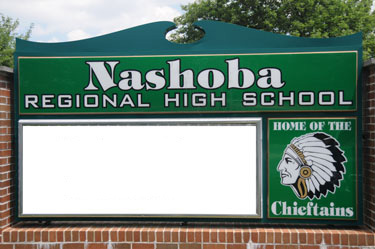
By Ann Needle
The Nashoba School Committee scrutinized possible cuts to its potential 2013/14 budget last night, with members agreeing to return later this month with decisions on what (if anything) could be trimmed. And, the school choice debate rolled on through sometimes heated discussion over whether profit from extra students makes up for resources that could be better used for residents.
At the Committee’s request during the last meeting, Wood presented what the $49.1 million proposed 2014 budget would look like if trimmed at three levels.
As Wood recommended it, a half-percent reduction could encompass cutting a planned technology position, reducing $20,000 from the upcoming bus contract, and scaling back the planned replacement of the district’s Foreign Language textbooks.
A 1% budget reduction would add to those cuts, trimming items including a planned Math Specialist position, and $10,000 from the Nashoba Regional High School non-salary budget.
At a 1.5% reduction, Wood said the cuts would likely mean layoffs and other items added to the lower-level suggestions for trimming. For instance, he recommended taking away a planned first grade teacher form both Center School in Stow and Lancaster’s Mary Rowlandson schools. The librarians at both Hale and Lancaster’s Luther Burbank middle schools could be replaced with instructional assistants.
Asked whether cuts could be selected from any of these three levels, Wood suggested he would prefer the Committee chooses one level. However, Committee members pledged to look over the numbers and come back with recommendations at the March 12 meeting, when they are scheduled to vote on a final budget.
In what has become an annual exercise, the Committee pondered whether to change the school choice program, or eliminate it altogether. The program allows students from other districts to attend Nashoba schools for a fee that is paid by the incoming student’s home district. Wood explained that, legally, the district could phase the program out, grade by grade, over 13 years if it chose, but could not “grandfather” in younger siblings of current choice students.
Though the program brings in $5,000 per pupil, it has reportedly worried some district parents, concerned with overcrowding and lost opportunities for their own children. For example, at a previous meeting, Lancaster Rep. Julie Fay asserted that a parent in her town complained their child was recommended for reading services, but could not receive them because the program — which included a few school choice students — was full.
There also was considerable discussion over whether Bolton would benefit more than Stow or Lancaster if choice were eliminated. Committee Co-Chair Nancy Federspiel of Bolton noted that, in the first year of choice, in 2007, Bolton’s Florence Sawyer School was overwhelmed with the 65 students that choiced in. Though there was space in some of the FSS classrooms, based on the maximum number of students recommended for each grade, Federspiel maintained that the overall burden on facilities and crowding has been overwhelming.
But Stow Rep. Jeff Odell asserted the revenue that would trickle away if the program were phased out would therefore hurt Stow and Lancaster, which could still have space. “We can’t get around that this is part of the budget. What we need to ask now is whether it is worth giving it up. Would it be worth smaller classes? I think so. But would it benefit one town disproportionately?”
Meanwhile, Michael Wood pointed out that school choice brings in a net of about $600,000 to Nashoba each year. For this school year, he reported the district received $1,142,885 for its 212 incoming choice students, while paying out $534,776 for the 73 Nashoba students who chose to attend other districts for which Nashoba needed to pay.
Wood stressed that there would only be about 25 total seats open next year in the district from kindergarten through grade 8. As for Stow, in 2013/14 there would be room for 5 students; 3 in grade 3, and 2 in grade 7.
Federspiel said the Committee would re-address whether to keep the program at the next meeting.
2013/14 Calendar Gets Okay
The Committee gave a unanimous nod to the 2013/14 calendar. Initially presented at the previous Committee meeting, the calendar has students returning to class Wednesday, August 28, a few days before Labor Day. (Without snow days, school will end June 13.)
Though 62% of parents responding to a district survey reported they would prefer going back after the holiday, Wood said that the earlier start will help guard against snow days or other obstacles pushing the school year into late June. Calendar Committee members also pointed to several other reasons, including carving out more instruction time before MCAS in the spring, and the tradition (before this school year) of starting before the holiday.
In individual school news, NRHS Teachers Leo Sakellarion and Laura Pagington outlined the process leading up to the introduction this month of the high school’s new core values statement of CARE (communicate, achieve, relate, and engage).
Spearheading the process of re-accreditation by the New England Association of Schools and Colleges, Pagington and Sakallerion explained that part of this process calls for re-evaluating the high school’s stated core values at least every 10 years. This involved a community forum in December of staff, students, and parents, to formulate the proposal, with NRHS staff approving the proposal earlier this month.
Pagington assured that the school plans an aggressive campaign to communicate these values to staff and students. By the time NEASC arrives at NRHS to start its evaluation process in 2015, Pagington declared, “If students are approached [by NEASC], they will be able to say, these are what our values are.”